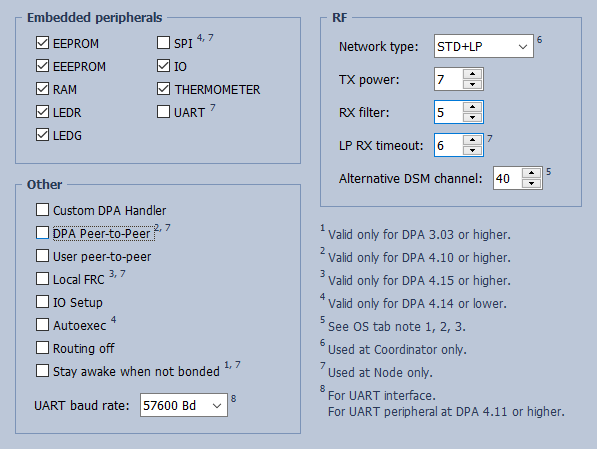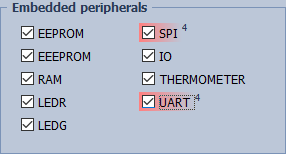•For applications based on DPA only.
•DPA specific configuration (depends on the DPA version, information below is valid for DPA v4.xx).

•Embedded peripherals
oAllows to enable or disable embedded DPA peripherals.
oSome peripherals can not be active simultaneously. Such conflict is indicated in red (see picture below). It is not allowed to upload a configuration with peripheral conflict.

•RF
oNetwork type (for DPA v4.00 or higher)
Type of the IQMESH network (used at the Coordinator only):
▪STD: The network supports Nodes using the STD RF mode only.
▪STD+LP: The network supports Nodes using the STD as well as the LP RF mode.
This parameter can only be changed if the network is empty (no Nodes are bonded) otherwise the network will stop working.
oTX power
RF output power. Valid values: 0 - 7 (max. RF power)
oRX filter
RF signal filter Valid values: 0 - 64 (min. RF sensitivity)
oLP RX timeout (for DPA v2.10 or higher)
Timeout for receiving RF packets at LP-RX mode at LP Node. The unit is one cycle (one cycle is 46 ms at LP-RX mode). Greater values save energy but might decrease responsiveness to the master interface DPA Requests and also decrease Idle event calling frequency. Valid values: 1 - 255
oAlternative DSM channel (for DPA v2.20 or higher)
Alternative DSM (DPA Service Mode) RF channel setting. After reset the DPA device first tries to establish DSM session at the dedicated channel number 0 and then it tries this optionally specified alternative channel. DPA Service Tool (e.g. CATS) must be set to use the same required channel for the DSM session. Alternative DSM channel will mainly be used in situations where a dedicated DSM channel 0 is noisy. Therefore it is not recommended to set this channel close to the channel 0. As well as do not use the same channel like application.
•Other
oCustom DPA Handler
If set, then a Custom DPA Handler is called in case of an event. The handler can define user peripherals, handle messages to embedded peripherals and add special user‑defined device behavior.
oDPA peer-to-peer (for DPA v4.10 or higher)
If set, then Node enables DPA peer-to-peer (DP2P) communication.
oUser peer-to-peer
If set, then when device receive peer-to-peer (non-networking) packet it raises DpaEvent_PeerToPeer event.
oLocal FRC (for DPA v4.15 or higher)
If set, then the Node receives local FRC commands.
oIO Setup
If set, then IO Setup is run at an early stage of the TR module boot time.
oAutoexec (for DPA v4.14 or lower)
If set, then DPA Autoexec is run at a later stage of the TR module boot time.
oRouting Off
If set, then the Node does not route packets in the background.
oStay awake when not bonded (for DPA v3.03 or higher)
If set, then unbonded Node never sleeps.
oUART interface Baud Rate
Baud rate of the DPA UART interface if one is used.¨